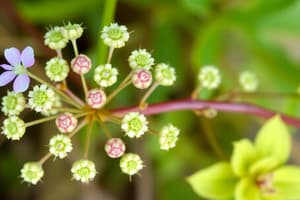Podcast
Questions and Answers
What is the primary function of leaves in a tree?
What is the primary function of leaves in a tree?
- To absorb water and nutrients from the soil
- To regulate the climate and weather patterns
- To provide protection and support
- To carry out photosynthesis (correct)
What is the main difference between a 'bug' and an 'insect'?
What is the main difference between a 'bug' and an 'insect'?
- Insects belong to a specific taxonomic group, while bugs do not (correct)
- Insects have four wings, while bugs have two
- Insects are typically larger than bugs
- Insects are found only in tropical regions, while bugs are found everywhere
What is the primary function of roots in a tree?
What is the primary function of roots in a tree?
- To regulate the climate and weather patterns
- To absorb water and nutrients from the soil (correct)
- To provide protection and support
- To carry out photosynthesis
What is the characteristic of coniferous plants?
What is the characteristic of coniferous plants?
What is the function of the exoskeleton in insects?
What is the function of the exoskeleton in insects?
Flashcards are hidden until you start studying
Study Notes
Plants and Trees
- Types of Plants:
- Flowering plants (angiosperms): produce flowers and seeds
- Coniferous plants (gymnosperms): produce cones and seeds
- Ferns (pteridophytes): non-flowering, spore-producing plants
- Importance of Plants:
- Produce oxygen through photosynthesis
- Provide food and shelter for animals
- Help regulate the climate and weather patterns
- Tree Characteristics:
- Trunk: main stem of the tree
- Bark: protective layer on the outside of the trunk
- Leaves: carry out photosynthesis
- Roots: absorb water and nutrients from the soil
Insects and Bugs
- Insect Characteristics:
- Exoskeleton: outer covering that provides protection and support
- Segmented body: divided into head, thorax, and abdomen
- Six legs: jointed legs for movement and sensory organs
- Compound eyes: made up of many small lenses for vision
- Types of Insects:
- Beetles (coleoptera): most diverse group of insects
- Flies (diptera): have a single pair of wings
- Bees and wasps (hymenoptera): have four wings and are social insects
- Bug vs. Insect:
- "Bug" often refers to any small, crawling creature
- Insects belong to the class Insecta, a specific taxonomic group
- Not all bugs are insects, but all insects are bugs
Plants and Trees
- Flowering plants produce flowers and seeds, while coniferous plants produce cones and seeds
- Ferns are non-flowering, spore-producing plants
- Plants produce oxygen through photosynthesis, providing food and shelter for animals and regulating the climate and weather patterns
- The trunk is the main stem of a tree, protected by the bark, and supported by roots that absorb water and nutrients from the soil
- Leaves carry out photosynthesis, the process by which plants produce energy from sunlight
Insects
- Insects have an exoskeleton, a segmented body divided into head, thorax, and abdomen, and six jointed legs
- Insects have compound eyes made up of many small lenses for vision
- Beetles are the most diverse group of insects, while flies have a single pair of wings and bees and wasps are social insects with four wings
- The term "bug" refers to any small, crawling creature, but insects belong to the specific taxonomic group Insecta
- Not all bugs are insects, but all insects are bugs
Studying That Suits You
Use AI to generate personalized quizzes and flashcards to suit your learning preferences.




